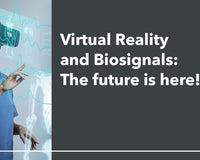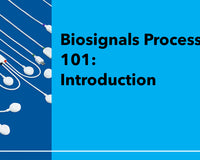Introduction
Biosignals are crucial in research fields such as clinical studies, sports science, and developing technologies that help computers understand human signals. These signals show how the body reacts and operates, making them essential for scientific progress. Choosing the right biosignal research system is critical. The right tools can lead to major discoveries, while the wrong ones might miss important information.
This guide will answer common and less obvious questions you might have about choosing biosignal tools. It aims to help you make the best decisions by providing clear information and expert advice.
What Will You Learn:
- Basics of Biosignals: Understand what biosignals are and their importance in research.
- Selecting Equipment: Find out how to choose the right biosignal research system for your projects.
- Advice from Experts: Get practical tips based on our extensive experience to improve your research.
Understanding Biosignals
What are Biosignals?
Biosignals are important signals that our bodies produce during different activities. These can be voluntary signals, like when we move our muscles, or involuntary, like the beating of our hearts.
These signals include various kinds, such as the electrical signals from our heart, brain waves, muscle movements, or even the simple act of breathing. They act like a language our body uses to tell us vital information about our health, well-being, and how we perform physically.
Biosignals are the building blocks of understanding human physiology, and their analysis holds the key to unlocking insights into areas as diverse as healthcare diagnostics, sports performance optimization, neurological research, and more. Measuring biosignals enables researchers and clinicians to examine and understand the human body and developing technology that help medical innovation.
Measuring Biosignals in Real-World Research Applications
Biosignal research systems are no longer just in labs. They are now used in many real-world situations. You might have seen the traditional, bulky systems ‘lab-looking’ equipment on a lab’s desktop or modern versions of portable multi-sensor systems. Nowadays, even consumer products have features and built-in sensors that may respond to some research needs.

In all these situations, the basic setup is similar: a sensor is attached to a person, and a device collects and records the data. This data can then be viewed on mobile or desktop software either immediately or later for more detailed study. In some cases, everything’s built into a single case while others have visibly connected components.
By defining your research goal in the next section before talking about which equipment might be best.
Defining Your Research Objectives
The right equipment is only the one that helps you meet your research goal. That’s why it is important to define what you want to achieve and understand the requirements of your research system.
To help you make the best choice, whether you're working with biosignals experts or selecting equipment yourself, consider these five key questions:
- How many participants will be monitored simultaneously?
Think about how many people you need to monitor at once. Sometimes you need several systems to monitor multiple participants at the same time, and other times, one system is enough. Determine the minimum and maximum number of participants to understand how many devices you will need. (usually recommended 1 device per participant).
- What are the key parameters for your research?
The need for a specific biosignal may not always be clear in advance to the research project. You might rather be familiar with the type of parameters you expect to observe. The parameters you select already reveal important information such as the number of sensors and sensor types needed for your research.
Knowing which biosignals you need to monitor is crucial. For example, if you need to monitor heart rates, decide whether you’ll use ECG (Electrocardiography), PPG (Photoplethysmography), or SpO2 (Blood Oxygen Saturation) sensors. Each has different benefits and limitations.
- Do you need to compromise on sensor placement?
In traditional clinical setups, the best sensor placement is often the one that follows clinical standards regardless of user mobility. Often, these have little impact as the participants are monitored in controlled and restricted environments.
In real-world experiments, this may not be the case. If participants need to move freely or use their hands, like when interacting with a computer, you might choose different sensors. For example, instead of a PPG sensor on the finger, you might use an ECG sensor.
- How much mobility is required in your research setup?
Whether participants will be sitting at a desk or moving around can influence your choice of equipment. Defining this mobility question helps quickly separating needs from desktop systems to wearable and wireless devices.
- How are you going to manage your recorded data?
Most research systems on the market come with their own signal acquisition software that allows you record and visualize the acquired sensor data within the software. However, not all come with built-in analysis tools or the option to export sensor data for you to process it elsewhere if the original software lacks any features.
It’s important to have a clear vision on what you expect from your software to understand its limitations or benefits. For instance, less tech-savvy users may prefer software that provides a full set of analysis results with the single press of a button while others prefer to work with developer tools and skip the original software all-together or are looking for third-party software support.
Types of Biosignal Research Systems
Biosignals research systems come in all sizes and form-factors, each offering unique benefits and challenges. Let’s have a look at the options.
- Desktop Systems
Biosignals desktop systems are common in labs where experiments don't change location. While you may encounter many systems with pre-set sensors, some also provide multi-channel acquisitions with the option to interchange sensors as you need for your research system.
While reliable, these systems often are limited to stationary experimental setups which can be limited in specific research areas, such as sports sciences or rehabilitation. Desktop systems also tend to be the most expensive options on the market, which might be compensated by their longevity.
- Consumer Wearables
Consumer wearables have found their way into every day lives and have become popular for research. These devices are less intrusive in real-world applications, have an attractive price and additional functionalities that may increase participant satisfaction outside of the research focus.
However, while attractive on various levels, consumer wearables often provide biosignals in a limited form. For instance, sports wearables with heart rate indicators may not provide you the live heart rate but instead average values over multiple heartbeats. While suitable for sports enthusiasts, this limitation might not be sufficient for deeper analysis of heart rate activity.
- Research Wearables
Research wearables take the best parts of consumer wearables, like their small size, light weight, and familiar form-factors plus wireless streaming features that provide medical-grade biosignal data.
These devices provide limited features for participants outside the research context, but have the needs of researchers in focus with high-quality data, ease-of-use, and increased mobility.

- Portable Multi-Sensor Systems
Portable multi-sensor systems combine the best of desktop solutions and research wearables by enabling the versatility of exchangeable multi-sensors setups without compromising on mobility or being reduced to stationary experiments only.
Multi-channel systems can cover the simplest to the most complex setups all while being lightweight and placed on the user directly. This allows more range of motion for participants in dynamic experiments, which can come in useful in sports sciences or virtual reality applications.
Also, allows you to upgrade your system over time to fit future research setups, increasing the longevity of the system beyond the originally intended research use.

Types of Biosignal Research Systems
Now that we have the critical high-level questions covered and know what types of biosignals system exists, let’s jump the details to find the best fit for your project.
Here are 6 crucial steps to guide you in finding the ideal equipment:
- Are my sensors of choice available?
Imagine you found the ideal acquisition system but it lacks critical sensors you need for your research. This can be a deal breaker if no alternative can be found or if it requires the use of additional systems which lead to further work on making them all work together.
Ideally, your system already comes with support for the sensor you need out of the box or provides additional tools that allow you to extend your setup with third-party sensors through standard interfaces, therefore compensating the lack of sensor while benefiting from all the other advantages of the system.
Make sure the system can meet your technical requirements like sampling frequency and resolution.
- Finding the best system based on the number of sensors needed
Consider how many sensors your research requires. Some projects might need a single-sensor, while others require multiple sensors operating simultaneously.
Once you’ve defined the number of sensors needed for your research project, you’re one step closer to finding a setup for which multiple solutions can be available.
For example, single-channel acquisitions systems are ideal for single-sensor recordings, while multiple sensors may be connected to multi-sensor systems that support the use of up to 4 sensors or even up to 8 sensors (and more).
We recommend trying to connect as many sensors to the same acquisition system per participants as this brings various benefits including:
- All sensors are recorded synchronously at the same time
- A single device is responsible for a collection of sensors' data stream (better communication stability)
- All sensor data from an individual participant are bundled through one system
In case you need to split the sensors among various participants, we recommend reserving one recording unit for each participant individually to which their sensors are connected. This not only helps clustering and linking signal acquisitions directly to each subject, but you also avoid practical issues such as that the motion of one participant interferes with another participant by being connected to the same system (it’ll definitely be safer for your equipment and your participants).
- Wireless Streaming or Data Logging?
Bluetooth streaming is one of the most commonly used methods of real-time data acquisition and streaming. While Bluetooth can be a reliable streaming source within most conditions (e.g. using a certified Bluetooth driver or dongle) some environments can lead to Bluetooth reliability issues.
In these cases, consider adding data logging features to your setup which allow you to stored the acquired sensor data locally to the acquisition device as a backup measure, while Bluetooth can still provide you a quick glimpse into your signals before the acquisition to ensure that each sensor is well placed.
- Convenient one-button signal analysis or Do-it-Yourself (DiY) signal processing with developer tools?
With varying levels of biosignal processing expertise, your system should fit your level and exceptions as best as possible.
User-friendly and easy-to-use signal acquisition, visualization, and processing software is a must for researchers that don’t want to spend much time tinkering with configurations and technical details but instead want to achieve quick results with the single press of a button.
Developers and researchers with focus on biosignal processing engineering on the other hand, may prefer to have full control of the recording hardware and sensor data to develop their own tools. In this case, developer tools and data export capabilities are a must-have feature.
Fortunately, some devices provide both options with the same system making it also usable for research groups with mixed level’s of technical knowledge. And for those who are in between both ends and want to learn, there are also plenty of programming tutorials available.
- Third-party compatibility
having the possibility to add third-party hardware to your setup or to export sensor data to third-party software can be a valuable asset.
Not only does it safe you a lot of time during the research project, it also greatly increases the capability of your research setup
While not always an immediate need, keep an eye open on third-party compatibility features (e.g., Lab Streaming Layer) of your system for future projects.
- Longevity, Extendability and Support
Longevity is not only given by the amount of time your device lasts until it breaks down, is discontinued, or stops being in use for any other reason.
Longevity is also supported by the amount of usefulness your new research system brings you beyond your current project. Ideally, you should be able to replace and exchange sensors so that your system also fits future projects without any drawbacks. This way, your system grows with you and your research.
And for the times that things go not as planned, evaluate the support that is provided to you either through personalized 1-on-1 support or through resources that are available at any time for a quick self-support.
Conclusion
We’ve shared the most frequently and challenging questions when it comes to finding a new suitable biosignals research system.
While the final system is not always immediately clear during the exploratory and planning phase of your research project, these questions aim to guide you finding a system that fits your needs best. And ideally, one that makes your life easier and helps you produce new knowledge and insights.
Now that you know how to find your ideal biosignals research system, you can built your own biosignals Kit.
Still need any help? Then talk to our biosignals Experts who will gladly give you a free consultation on finding the best biosignals research setup.









